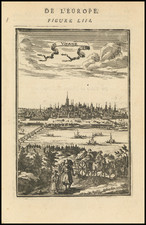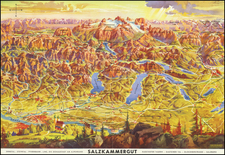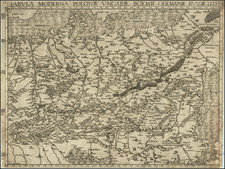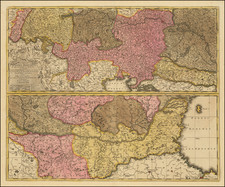Fortified Vienna Following the Battle of Vienna in 1683
Rare fortified plan of Vienna, published by Vincenzo Maria Coronelli in Venice.
The map is issued shortly after a two month siege of Vienna and the so-called Battle of Vienna in 1683, one of the most significant events in the war with the Ottomans. The battle was fought by the Holy Roman Empire led by the Habsburg Monarchy and the Polish–Lithuanian Commonwealth, both under the command of King John III Sobieski, against the Ottomans and their vassal and tributary states. The battle marked the first time the Commonwealth and the Holy Roman Empire had cooperated militarily against the Ottomans, and it is often seen as a turning point in history, after which the Ottoman Turks ceased to be a menace to the Christian world and were increasingly pushed out of southern Europe. In the ensuing war that lasted until 1699, the Ottomans lost almost all of Hungary to the Holy Roman Emperor Leopold I.
This example of the map is taken from Coronelli's rare work Citta, Fortezze e, Isole, e Porti principali dell'Europa in Pianta et in Elevatione, Descritte, e Publicate Ad uso dell'Accademia Cosmografica degli Argonauti dal Padre Maestro Coronelli Lettore, e Cosmografo della Serenissima Republica di Venezia, printed in Venice by Domenico Padovani in 1689.
Vincenzo Maria Coronelli (1650-1718) was one of the most influential Italian mapmakers and was known especially for his globes and atlases. The son of a tailor, Vincenzo was apprenticed to a xylographer (a wood block engraver) at a young age. At fifteen he became a novice in a Franciscan monastery. At sixteen he published his first book, the first of 140 publications he would write in his lifetime. The order recognized his intellectual ability and saw him educated in Venice and Rome. He earned a doctorate in theology, but also studied astronomy. By the late 1670s, he was working on geography and was commissioned to create a set of globes for the Duke of Parma. These globes were five feet in diameter. The Parma globes led to Coronelli being named theologian to the Duke and receiving a bigger commission, this one from Louis XIV of France. Coronelli moved to Paris for two years to construct the King’s huge globes, which are 12.5 feet in diameter and weigh 2 tons.
The globes for the French King led to a craze for Coronelli’s work and he traveled Europe making globes for the ultra-elite. By 1705, he had returned to Venice. There, he founded the first geographical society, the Accademia Cosmografica degli Argonauti and was named Cosmographer of the Republic of Venice. He died in 1718.











![[ Tyrolean Alps ] Status Tirolensis qui Complectiture Ipsissimum ejuldem Nominis et Anexum ei Brigantinae Comitatus. . .](https://storage.googleapis.com/raremaps/img/small/77215.jpg)
![[ Austro-Turkish War ] Zum ersten quartal des Krigsweisers](https://storage.googleapis.com/raremaps/img/small/97836.jpg)

